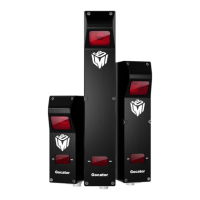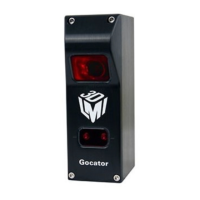Gocator Line Profile Sensors: User Manual
Gocator Web Interface • 440
activates after the sensor finishes processing the data. As a result, the time between the start of sensor
exposure and output activates can vary and is dependent on the processing latency. The latency is
reported in the dashboard and in the health messages.
8. If you checked Scheduled, specify a delay and a delay domain.
The Delay specifies the time or encoder distance between the start of sensor exposure and when the
output becomes active. The delay should be larger than the time needed to process the data inside the
sensor. It should be set to a value that is larger than the processing latency reported in the dashboard
or in the health messages.
The unit of the delay is configured with the Delay Domain setting.
9. If you want to invert the output signal, check Invert Output Signal.
To output a measurement valid signal:
1. Go to the Output page.
2. Click on Digital 1 or Digital 2 in the Output panel.
3. Set Trigger Event to Measurement.
4. In Configuration, set Assert On to Always.
5. Select the measurements.
The output activates when the selected decisions produce results. The output activates only once for
each frame even if multiple decision sources are selected.
6. Specify a pulse width using the slider.
The pulse width determines the duration of the digital output pulse, in microseconds.
To respond to software scheduled commands:
1. Go to the Output page.
2. Click Digital 1 or Digital 2 in the Output panel.
3. Set Trigger Event to Software.
4. Specify a Signal type.
The signal type specifies whether the digital output is a continuous signal or a pulsed signal. If the
signal is continuous, its state is maintained until the next transition occurs. If the signal is pulsed, user
specifies the pulse width and the delay.
5. Specify a Pulse Width.
The pulse width determines the duration of the digital output pulse, in microseconds.
6. Specify if the output is immediate or scheduled.
A pulsed signal can become active immediately or be scheduled. A continuous signal always becomes
active immediately.
Immediate output becomes active as soon as a scheduled digital output (Schedule Digital Output on
page 596) is received.
Scheduled output becomes active at a specific target time or position, given by the Scheduled Digital
